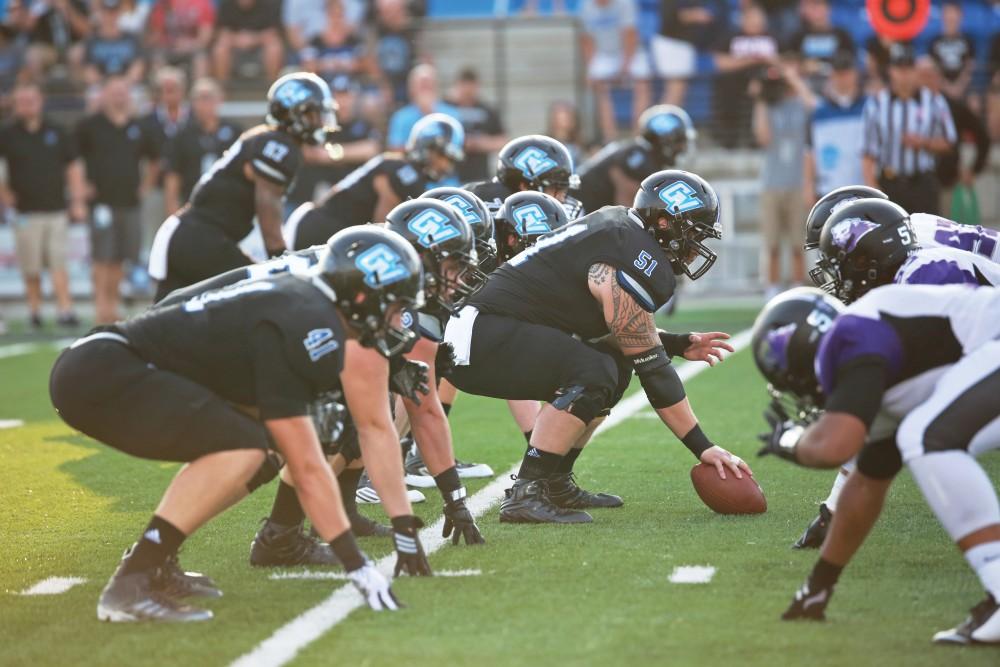GVSU study suggests lineman getting too large

GVL / Kevin Sielaff Offensive lineman Aaron Cox (51) looks to hike the ball. Grand Valley State squares off against Southwest Baptist Thursday, September 3rd, 2015 at Lubbers Stadium.
Feb 1, 2016
Recent research published by a Grand Valley State movement science professor and one of his students suggests that football offensive and defensive linemen are getting too big for their own good.
Jeffrey Potteiger, professor of exercise science, and Maggie McGowan-Stinski, senior athletic training major, collected and analyzed data to examine how body size has changed in college and professional football players over the past 70 years.
According to the research, while most position players have increased in both height and body mass from 1942 to 2011, the largest gains in body mass have occurred among offensive and defensive linemen.
“If you go back to the 1960s and 1970s, offensive and defensive linemen were 250-260 pounds and now you can’t play offensive or defensive line if you’re not 300-plus pounds,” Potteiger said.
This increase in weight and body mass to maintain the ability to compete has put these players at higher risk for health problems including high blood pressure, diabetes, cardiovascular disease and metabolic syndrome.
Therefore, the research duo advises, sports medicine teams should have an evaluation and treatment plan available to reduce the risk for disease both during and after players’ football careers, because the issue isn’t going to go away anytime soon.
“When you think of offensive linemen, most college and professional games have more of a pass-orientated attack and so it’s about protecting the quarterback,” Potteiger said. “So, if you’re big, strong and hard to push out of the way and take up a lot of space, then you can do your job.
“(Defensively) you don’t want to be moved out of the way because you are there to stop the run and from a quickness standpoint you only have to go five yards either way, and so speed is not that much of an issue. It’s about how big you are and what kind of foot movement you have.”
While there is a strong correlation between excess body mass and poor health, GVSU head football coach Matt Mitchell expressed his concern that this isn’t just offensive and defensive line problem. Anyone with a high body mass is subjected to health complications.
“These are people who have higher body masses because of the requirements of the position and they are probably at more risk than others that aren’t,” Mitchell said. “But, I don’t think this is inclusive to just the population of offensive and defensive linemen. It’s anybody that’s walking the face of this planet.”
Similarly to what the research recommends, the GVSU football program diligently monitors its players, during the season and offseason.
“We weigh them frequently,” Mitchell said. “I trust our trainers here. They take blood pressure, physicals when they walk through the door and we have had some kids that (needed) follow-ups because of blood pressure and other things, and those are typically more of the offensive and defense linemen types than the skill guys.
“If they come in for the physical and show high blood pressure then they are shut down for practice and have to see a physician, and they put together a plan to lower their blood pressure.”
Exercise, medication and diet changes are then implemented to get the athlete at a level the coaching and medical staff feel like they can be a full participant.
Life after football can be a difficult transition period for these players. The athletes that are in serious risk are the ones who don’t change their mentality once their playing days are over, Mitchell said.
“This is in general and not specific to Grand Valley State, but take a look at the offensive and defensive linemen, (those) are the guys that get done playing and continue to be at that weight or increase their weight. Even though their physical activity has gone down, they still have that same caloric intake and that puts them at a higher risk. There is no doubt about that.”
While there is cause for concern that offensive and defensive linemen have gotten larger and need to be closely watched as provided by the research, Mitchell said the most important thing is what happens after players hang up their shoulder pads for the last time.
“What I think is really critical is when you’re done playing those positions – and we have had guys who have done it – is changing the type of athlete you are. We play football, it’s a power sport. It’s less cardiovascular, it’s more anaerobic.”





















